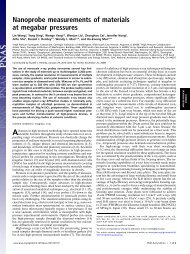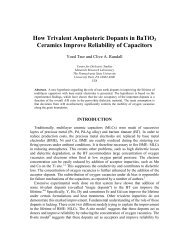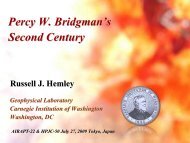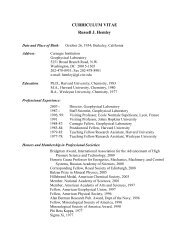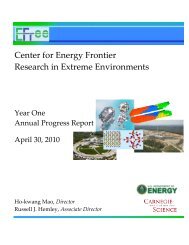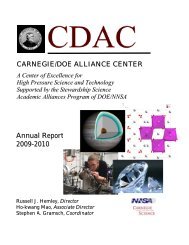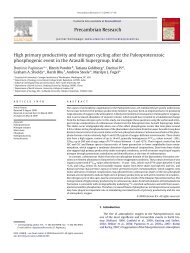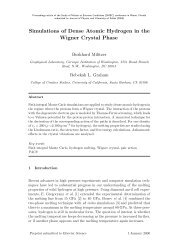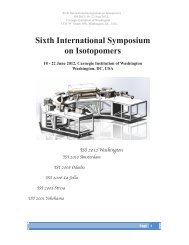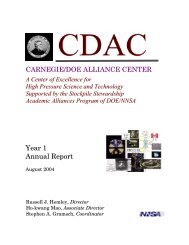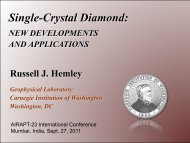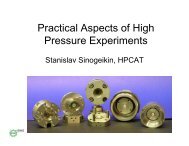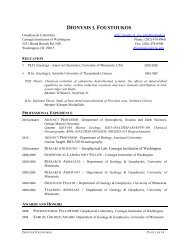Herd C. D. K., A. Blinova, D. N. Simkus, Y. Huang, R. Tarozo, C. M. O ...
Herd C. D. K., A. Blinova, D. N. Simkus, Y. Huang, R. Tarozo, C. M. O ...
Herd C. D. K., A. Blinova, D. N. Simkus, Y. Huang, R. Tarozo, C. M. O ...
You also want an ePaper? Increase the reach of your titles
YUMPU automatically turns print PDFs into web optimized ePapers that Google loves.
REPORTS<br />
served in 5b, were accreted, along with (presumably)<br />
amino acid precursors. The a-amino acids<br />
were probably produced during alteration on the<br />
Tagish Lake parent body, presumably by Strecker<br />
synthesis (37, 39), although other formation mechanisms<br />
for both a and other amino acids before<br />
their incorporation in the parent body have<br />
been suggested (40). Modest alteration may<br />
have produced light acetic acid and an initial<br />
complement of MCAs from IOM, by analogy<br />
with experiments (11), as well as a slight ee in<br />
isovaline, to provide the SOM characteristics<br />
observed in 5b. These components were then<br />
modified on the parent body through further hydrothermal<br />
alteration, resulting in reduction of<br />
aliphatic character and D/H in IOM, exchange of<br />
isotopically heavy C with MCA carboxyl C, production<br />
of glycine, and a fresh influx of racemic<br />
amino acids, as represented by organic matter in<br />
11h. By analogy with MCAs, the exchange of<br />
isotopically heavy C with amino acid carboxyl C<br />
may explain the positive d 13 C values of amino<br />
acids in 11h (such as glycine). The increase in<br />
IOM d 13 C with the degree of alteration (Table 1)<br />
is consistent with the loss of isotopically lighter<br />
C, associated with aliphatics, such as MCAs in<br />
11i and 11v. Further hydrothermal alteration resulted<br />
in further modification of IOM and decreases<br />
in overall concentration of MCAs in 11i<br />
and 11v and a nearly complete loss of amino<br />
acids in 11i. The conditions of hydrothermal alteration<br />
inferred by analogy with experiments,<br />
especially temperature (~300°C) (10, 11, 25), are<br />
at odds with the mineralogy and preservation of<br />
volatile organic compounds, which provide an<br />
upper limit of ~150°C (23). The Tagish Lake<br />
specimens may therefore have experienced alteration<br />
at lower temperatures than those in the<br />
experiments, with the more extensively altered<br />
samples having been subjected to longer periods<br />
of alteration, higher temperatures, and/or higher<br />
water/rock ratios (11).<br />
References and Notes<br />
1. E. R. D. Scott, A. N. Krot, in Treatise on Geochemistry,<br />
H. D. Holland, K. K. Turekian, Eds. (Elsevier Pergamon,<br />
Oxford, 2007), vol. 1, pp. 1–72.<br />
2. I. Gilmour, in Treatise on Geochemistry, H. D. Holland,<br />
K. K. Turekian, Eds. (Elsevier Pergamon, Oxford, 2003),<br />
vol. 1, pp. 269–290.<br />
3. O. Botta, J. L. Bada, Surv. Geophys. 23, 411<br />
(2002).<br />
4. J. R. Cronin, S. Pizzarello, D. P. Cruikshank, in Meteorites<br />
and the Early Solar System, J. F. Kerridge,<br />
M. S. Matthews, Eds. (Univ. of Arizona Press, Tucson,<br />
AZ, 1988), pp. 819–857.<br />
5. H. Busemann et al., Science 312, 727 (2006).<br />
6. S. A. Sandford et al., Science 314, 1720 (2006).<br />
7. J. Duprat et al., Science 328, 742 (2010).<br />
8. C. M. O. D. Alexander, M. Fogel, H. Yabuta, G. D. Cody,<br />
Geochim. Cosmochim. Acta 71, 4380 (2007).<br />
9. C. F. Chyba, P. J. Thomas, L. Brookshaw, C. Sagan,<br />
Science 249, 366 (1990).<br />
10. Y. <strong>Huang</strong>, M. R. Alexandre, Y. Wang, Earth Planet.<br />
Sci. Lett. 259, 517 (2007).<br />
11. Y. Oba, H. Naraoka, Meteorit. Planet. Sci. 41, 1175<br />
(2006).<br />
12. L. Remusat, S. Derenne, F. Robert, H. Knicker, Geochim.<br />
Cosmochim. Acta 69, 3919 (2005).<br />
13. Information on materials and methods is available as<br />
supporting material on Science Online.<br />
14. Hydrothermal alteration occurred early in the history<br />
of the carbonaceous chondrite parent bodies owing to<br />
accumulation of the heat of radioactive decay, so that<br />
liquid water was transiently present and percolated<br />
through the mineral matrix. The evidence for this<br />
process is preserved in mineral alterations. Furthermore,<br />
in the interior of the parent body, the temperature<br />
and pressure can rise high enough to produce<br />
hydropyrolysis of organic material.<br />
15. M. E. Zolensky et al., Meteorit. Planet. Sci. 37, 737<br />
(2002).<br />
16. T. Hiroi, M. E. Zolensky, C. M. Pieters, Science 293,<br />
2234 (2001).<br />
17. M. M. Grady, A. B. Verchovsky, I. A. Franchi, I. P. Wright,<br />
C. T. Pillinger, Meteorit. Planet. Sci. 37, 713 (2002).<br />
18. S. Pizzarello et al., Science 293, 2236 (2001).<br />
19. G. Kminek, O. Botta, D. P. Glavin, J. L. Bada, Meteorit.<br />
Planet. Sci. 37, 697 (2002).<br />
20. K. Nakamura-Messenger, S. Messenger, L. P. Keller,<br />
S. J. Clemett, M. E. Zolensky, Science 314, 1439<br />
(2006).<br />
21. R.K.<strong>Herd</strong>,C.D.K.<strong>Herd</strong>,Lunar Planet. Sci. XXXVIII, abstr.<br />
2347 (2007).<br />
22. P. G. Brown et al., Science 290, 320 (2000).<br />
23. A. J. Brearley, in Treatise on Geochemistry, H. D. Holland,<br />
K. K. Turekian, Eds. (Elsevier Pergamon, Oxford, 2003),<br />
vol. 1, pp. 247–268.<br />
24. A. L. D. Kilcoyne et al., J. Synchrotron Radiat. 10, 125<br />
(2003).<br />
25. H. Yabuta, L. B. Williams, G. D. Cody, C. M. O. Alexander,<br />
S. Pizzarello, Meteorit. Planet. Sci. 42, 37 (2007).<br />
26. G. D. Cody, C. M. O. D. Alexander, Geochim. Cosmochim.<br />
Acta 69, 1085 (2005).<br />
27. M. C. Anguera et al., J. Biol. Chem. 281, 18335<br />
(2006).<br />
28. G. K. Smith, W. T. Mueller, L. J. Slieker, C. W. DeBrosse,<br />
S. J. Benkovic, Biochemistry 21, 2870 (1982).<br />
29. D. Deamer, J. P. Dworkin, S. A. Sandford, M. P. Bernstein,<br />
L. J. Allamandola, Astrobiology 2, 371 (2002).<br />
30. Y. S. <strong>Huang</strong> et al., Geochim. Cosmochim. Acta 69, 1073<br />
(2005).<br />
31. G. Yuen, N. Blair, D. J. Des Marais, S. Chang, Nature<br />
307, 252 (1984).<br />
32. R. F. Dias, K. H. Freeman, M. D. Lewan, S. G. Franks,<br />
Geochim. Cosmochim. Acta 66, 2755 (2002).<br />
33. D. P. Glavin, J. P. Dworkin, Proc. Natl. Acad. Sci. U.S.A.<br />
106, 5487 (2009).<br />
34. R. Bowen, in Isotopes in the Earth Sciences, R. Bowen,<br />
Ed. (Kluwer, New York, 1988), pp. 452–469.<br />
35. D. P. Glavin, M. P. Callahan, J. P. Dworkin, J. E. Elsila,<br />
Meteorit. Planet. Sci. 45, 1948 (2010).<br />
36. J. R. Cronin, S. Pizzarello, S. Epstein, R. V. Krishnamurthy,<br />
Geochim. Cosmochim. Acta 57, 4745 (1993).<br />
37. E. T. Peltzer, J. L. Bada, G. Schlesinger, S. L. Miller,<br />
Adv. Space Sci. 4, 69 (1984).<br />
38. S. Pizzarello, M. Zolensky, K. A. Turk, Geochim.<br />
Cosmochim. Acta 67, 1589 (2003).<br />
39. E. T. Peltzer, J. L. Bada, Nature 272, 443 (1978).<br />
40. J. E. Elsila, J. P. Dworkin, M. P. Bernstein, M. P. Martin,<br />
S. A. Sandford, Astrophys. J. 660, 911 (2007).<br />
41. Where given, the errors are half the difference<br />
(standard error of the mean) between the compositions<br />
of two residues prepared from two separate aliquots of<br />
each specimen. Typically, the differences in elemental<br />
ratios and isotopic compositions are larger than the<br />
intrinsic measurement precisions. Where only one<br />
measurement was made, the uncertainties of the other<br />
samples are a guide to the likely uncertainties.<br />
Acknowledgments: Funding for this study was provided by the<br />
Natural Sciences and Engineering Research Council of<br />
Canada, Alberta Innovates, NASA (Astrobiology, including<br />
Carnegie Institution Astrobiology and the Goddard Center<br />
for Astrobiology; Origins of Solar Systems; Cosmochemistry<br />
and Postdoctoral Programs), the U.S. Office of Naval<br />
Research, the CIW, Grant MacEwan University, and the<br />
Carnegie Institution of Canada. The Canadian Institute for<br />
Advanced Research is thanked for hosting workshops that<br />
facilitated work on the MCAs. J. Kirby assisted with MCA<br />
analysis. R. Bowden carried out bulk IOM analyses. XANES<br />
data were acquired on the Scanning Transmission X-ray<br />
Microscope at beamline 5.3.2.2 of the Advanced Light<br />
Source, which is supported by the Director of the Office of<br />
Science, U.S. Department of Energy, under contract no.<br />
DE-AC02-05CH11231, and by a W.M. Keck Foundation grant<br />
to the CIW. Three anonymous reviewers are thanked<br />
for constructive comments that improved the manuscript.<br />
Supporting Online Material<br />
www.sciencemag.org/cgi/content/full/332/6035/1304/DC1<br />
Materials and Methods<br />
Figs. S1 to S5<br />
Tables S1 to S4<br />
References (42–50)<br />
25 January 2011; accepted 6 May 2011<br />
10.1126/science.1203290<br />
Activation of Visual Pigments<br />
by Light and Heat<br />
Dong-Gen Luo, 1,3 * Wendy W. S. Yue, 1,3,4 Petri Ala-Laurila, 5,6 King-Wai Yau 1,2,3 *<br />
Vision begins with photoisomerization of visual pigments. Thermal energy can complement<br />
photon energy to drive photoisomerization, but it also triggers spontaneous pigment activation<br />
as noise that interferes with light detection. For half a century, the mechanism underlying this<br />
dark noise has remained controversial. We report here a quantitative relation between a<br />
pigment’s photoactivation energy and its peak-absorption wavelength, l max . Using this relation<br />
and assuming that pigment activations by light and heat go through the same ground-state<br />
isomerization energy barrier, we can predict the relative noise of diverse pigments with<br />
multi–vibrational-mode thermal statistics. The agreement between predictions and our<br />
measurements strongly suggests that pigment noise arises from canonical isomerization.<br />
The predicted high noise for pigments with l max in the infrared presumably explains why they<br />
apparently do not exist in nature.<br />
Our visual system has an extremely high<br />
sensitivity to light under dark-adapted<br />
conditions (1). This feat requires a phototransduction<br />
mechanism with high amplification<br />
(2) and a thermally quiet visual pigment for minimizing<br />
noise. Thermal energy is a double-edged<br />
Downloaded from www.sciencemag.org on June 9, 2011<br />
www.sciencemag.org SCIENCE VOL 332 10 JUNE 2011 1307



